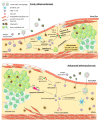CD8+ T Cells in Atherosclerosis
- PMID: 33383733
- PMCID: PMC7823404
- DOI: 10.3390/cells10010037
CD8+ T Cells in Atherosclerosis
Abstract
Atherosclerotic lesions are populated by cells of the innate and adaptive immune system, including CD8+ T cells. The CD8+ T cell infiltrate has recently been characterized in mouse and human atherosclerosis and revealed activated, cytotoxic, and possibly dysfunctional and exhausted cell phenotypes. In mouse models of atherosclerosis, antibody-mediated depletion of CD8+ T cells ameliorates atherosclerosis. CD8+ T cells control monopoiesis and macrophage accumulation in early atherosclerosis. In addition, CD8+ T cells exert cytotoxic functions in atherosclerotic plaques and contribute to macrophage cell death and necrotic core formation. CD8+ T cell activation may be antigen-specific, and epitopes of atherosclerosis-relevant antigens may be targets of CD8+ T cells and their cytotoxic activity. CD8+ T cell functions are tightly controlled by costimulatory and coinhibitory immune checkpoints. Subsets of regulatory CD25+CD8+ T cells with immunosuppressive functions can inhibit atherosclerosis. Importantly, local cytotoxic CD8+ T cell responses may trigger endothelial damage and plaque erosion in acute coronary syndromes. Understanding the complex role of CD8+ T cells in atherosclerosis may pave the way for defining novel treatment approaches in atherosclerosis. In this review article, we discuss these aspects, highlighting the emerging and critical role of CD8+ T cells in atherosclerosis.
Keywords: CD8+ T cells; atherosclerosis; checkpoint inhibitors; cytotoxic T cells; immunotherapy; inflammation; single cell RNA sequencing.
Conflict of interest statement
The authors declare no conflict of interest.
Figures


Similar articles
-
Cytotoxic and proinflammatory CD8+ T lymphocytes promote development of vulnerable atherosclerotic plaques in apoE-deficient mice.Circulation. 2013 Mar 5;127(9):1028-39. doi: 10.1161/CIRCULATIONAHA.112.001347. Epub 2013 Feb 8. Circulation. 2013. PMID: 23395974
-
Deficiency of the T cell regulator Casitas B-cell lymphoma-B aggravates atherosclerosis by inducing CD8+ T cell-mediated macrophage death.Eur Heart J. 2019 Jan 21;40(4):372-382. doi: 10.1093/eurheartj/ehy714. Eur Heart J. 2019. PMID: 30452556 Free PMC article.
-
CD8+ T-cells contribute to lesion stabilization in advanced atherosclerosis by limiting macrophage content and CD4+ T-cell responses.Cardiovasc Res. 2019 Mar 15;115(4):729-738. doi: 10.1093/cvr/cvy261. Cardiovasc Res. 2019. PMID: 30335148
-
Protective and pathogenic roles of CD8+ T cells in atherosclerosis.Basic Res Cardiol. 2016 Nov;111(6):71. doi: 10.1007/s00395-016-0589-7. Epub 2016 Oct 25. Basic Res Cardiol. 2016. PMID: 27783202 Review.
-
Activated T-effector seeds: cultivating atherosclerotic plaque through alternative activation.Am J Physiol Heart Circ Physiol. 2019 Jun 1;316(6):H1354-H1365. doi: 10.1152/ajpheart.00148.2019. Epub 2019 Mar 29. Am J Physiol Heart Circ Physiol. 2019. PMID: 30925075 Free PMC article. Review.
Cited by
-
Inflammation and atherosclerosis: signaling pathways and therapeutic intervention.Signal Transduct Target Ther. 2022 Apr 22;7(1):131. doi: 10.1038/s41392-022-00955-7. Signal Transduct Target Ther. 2022. PMID: 35459215 Free PMC article. Review.
-
Crosstalk between dendritic cells and T lymphocytes during atherogenesis: Focus on antigen presentation and break of tolerance.Front Cardiovasc Med. 2022 Jul 28;9:934314. doi: 10.3389/fcvm.2022.934314. eCollection 2022. Front Cardiovasc Med. 2022. PMID: 35966516 Free PMC article. Review.
-
Ferroptosis: a new strategy for cardiovascular disease.Front Cardiovasc Med. 2023 Sep 4;10:1241282. doi: 10.3389/fcvm.2023.1241282. eCollection 2023. Front Cardiovasc Med. 2023. PMID: 37731525 Free PMC article. Review.
-
ApoB-Specific CD4+ T Cells in Mouse and Human Atherosclerosis.Cells. 2021 Feb 19;10(2):446. doi: 10.3390/cells10020446. Cells. 2021. PMID: 33669769 Free PMC article. Review.
-
Regulatory T Cell-Enhancing Therapies to Treat Atherosclerosis.Cells. 2021 Mar 24;10(4):723. doi: 10.3390/cells10040723. Cells. 2021. PMID: 33805071 Free PMC article. Review.
References
Publication types
MeSH terms
LinkOut - more resources
Full Text Sources
Medical
Research Materials

